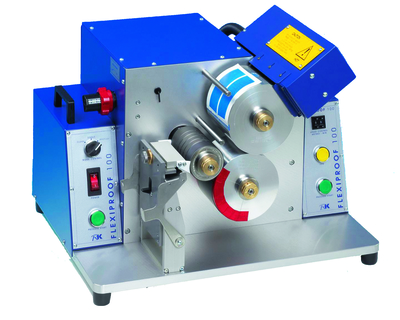UV flexo has and continues to have an impact on the display and marketing of health and beauty items and on the functionality of the packaging. The high solids content of the inks means that they can provide high gloss, high scuff, heat resistance and excellent resistance against chemicals.
The advantages of UV flexo makes it ideal for use on products that might be subject to bumping and scuffing during transportation, when displayed on a retail shelf and when taken home by the consumer and used in the hot and steamy environment of a shower or bathroom.
The ability to produce a finished product inline and, if properly cured rewound without fear of later blocking is advantageous, especially where short run orders are concerned and where speed to market is an issue.
‘UV flexo with its attendant advantages competes well with screen when high impact colour is required, which is so often the case in health, beauty and care products,’ said Tom Kerchiss of colour communication technology specialist, RK Print Coat Instruments Ltd. ‘Speaking of screen, an oft cited advantage is the ability to produce an excellent opaque white, which is often of particular importance when producing labels for glass containers. While it is fair to say that flexography can produce a washed out look in the described situation, UV flexo now provides a good alternative to screen when opaque colours are needed.’
Many of substrates being specified are heat sensitive. Improved reflector geometry and better heat management counter the problems that UV curing systems once had and which restricted substrate usage. Significant technological improvement in lamp technologies also bode well for the future with regard to heat management. UV LED curing systems provide benefits such as minimal heat/energy transfer to the substrate. It also provides uniform and consistent radiation across the width of the web. UV LED technology is available as an option with RK Print Coat Instruments flexo pre-press quality control and product development tool, the FlexiProof UV.
The nature of UV inks
Printing with UV inks undoubtedly can make for a beautiful product; the low to no VOC content, the fact that the inks stay open on the press, all contribute to the advantages. The downside is that some printers still struggle with consistency from press to press. Understanding the release characteristics of the ink in relation to the anilox roller is important. While a printer may obtain excellent results using a 60 degree hexagonal design anilox roller with water-based inks, the inherently thicker nature of UV inks can result in turbulence at the ink transfer point, and rather than bridging from one cell to the next, the fluidity or viscosity of the ink can produce a tidal wave effect. When the doctor blade meters the ink, the tidal wave of ink can cause the blade to chatter resulting in ink spitting and inconsistent ink film and blemishes on a printed surface.
‘Obtaining colour consistency can be challenging at the best of times, but given the different UV ink handling requirements coupled with the short run nature of many of the jobs means that the printer needs to be on top of the game. The need to colour match and control variables in the shortest possible time is vital,’ said Mr Kerchiss.
An ideal solution would be to print and cure offline so as not to tie up valuable press time. One of the problems in the past was that monitoring and controlling colour and other print inconsistencies was difficult using conventional methods. During the time taken to make a proof and take it to a UV conveyor, the surface properties altered as a result of chemical changes.
An ideal solution, unavailable until comparatively recently is to print and cure off press using an integrated flexo proofing device that replicates the conditions that one would normally be found on a typical production press. Such a system would minimise much of the on-press material waste generated when bringing print into register, speed make ready and make for better man and production machine management.
The Flexiproof UV makes productivity goals and quality aspirations more readily obtainable. Incorporating a miniaturised UV curing system, it is equipped with flexo critical components making it suitable for trialling new or unfamiliar substrates, inks and other components.
One of the advantages of the FlexiProof is that it can be installed and used throughout the supply chain in order that results can be duplicated and documented by the printer, the ink/coating supplier, substrate producer and other relevant parties. Invaluable, especially where ISO and other accredited standards must be adhered too.






